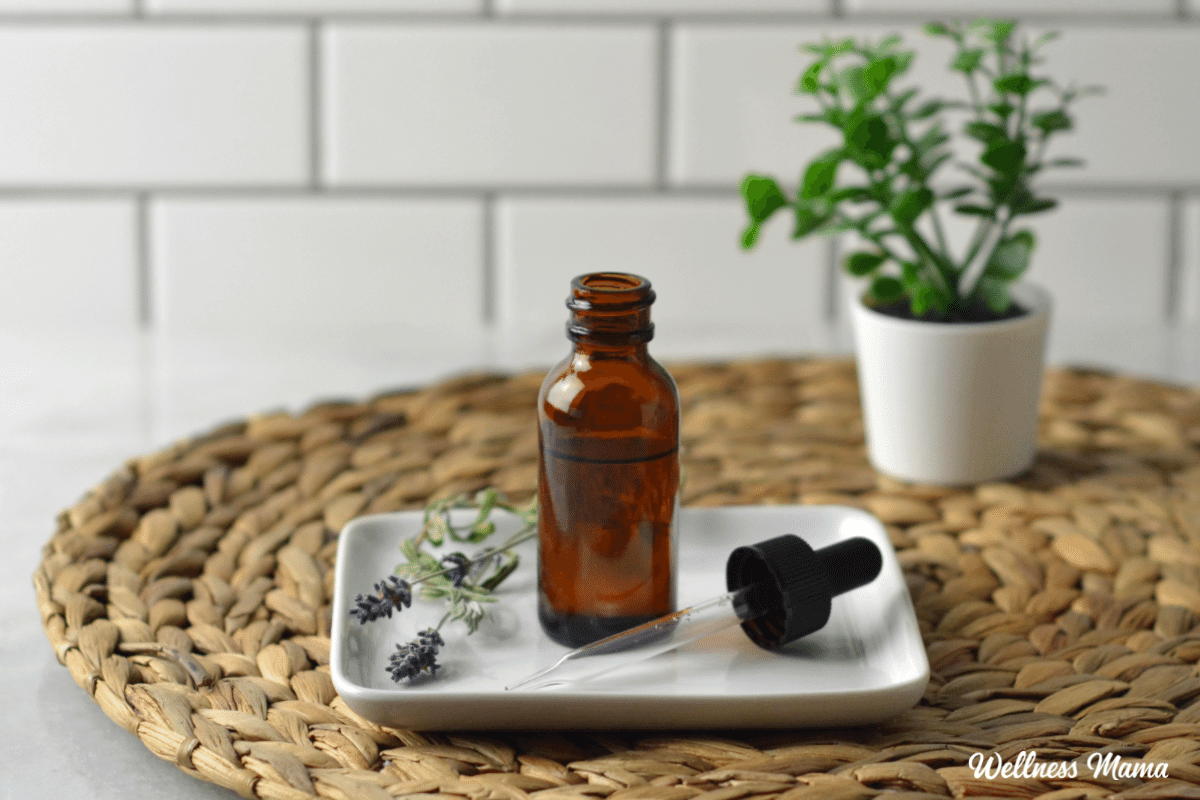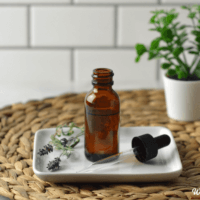Bakuchiol serum is increasing in popularity with more and more brands adding it to their skincare products. You can make your own an all-natural version with babchi oil (the plant it comes from) and customize it for your skin. This recipe is full of antioxidants and helps fight signs of aging and blemishes.
What is Bakuchiol Serum?
I’ve talked about bakuchiol (psoralea corylifolia) before and why it’s a little different than babchi oil. Essentially, bakuchiol is one of the constituents derived from the babchi plant. While it’s a powerhouse on its own, the components of the whole plant work synergistically together. Both ingredients are used in skincare, but babchi is the pure, pressed seed oil of the plant.
A lot of bakuchiol serums have an ingredient list longer than my arm (plus they can get pricey!). So I wanted to come up with a DIY bakuchiol serum alternative.
DIY Bakuchiol Serum
I used babchi seed oil in this recipe for several reasons. It’s less processed than bakuchiol and it’s oil soluble. Bakuchiol dissolves best in alcohol and certain chemicals (though it is oil soluble) so it can be a little trickier to work with. If you have bakuchiol and want to use that instead you can. It’s highly concentrated so you don’t need much, only 2-3 drops in this recipe. Any more can cause skin irritation.
Bakuchiol vs Retinol
Bakuchiol is commonly called a retinol alternative. They both reduce the appearance of fine lines and improve skin texture. But many people with sensitive skin find retinol can cause side effects. And dermatologists don’t recommend retinol during pregnancy (it’s toxic!).
Babchi oil or bakuchiol has a whole host of skincare benefits. It works as a brightening moisturizer for all skin types and improves skin tone. The babchi plant also has a long list of traditional medicinal uses.
Bakuchiol Skin Benefits
It’s often used as an anti-aging ingredient because of its antioxidant and firming properties. This beauty product is more than just a natural retinol alternative serum. Bakuchiol or babchi are also good for breakouts and acne-prone skin. Here are some other ways babchi and bakuchiol products benefit the skin.
- Reduces dark spots, hyperpigmentation, and discoloration.
- Improves elasticity
- Fights free radicals to protect skin cells
- Boosts collagen production to restore firmness
- Adds hydration and is good for dry skin
- Leaves skin feeling fresh and nourished
Which Products or Ingredients Go Well with Bakuchiol?
Retinol can negatively interact with other exfoliation ingredients or toners to cause irritation. Unlike retinol, bakuchiol plays nicely with other skincare ingredients. You can use bakuchiol skincare alongside a vitamin C serum, squalene, hyaluronic acid, glycerin, aloe, or niacinamide.
Anti-aging Skin Serum Ingredients
I’ve combined the babchi oil with a blend of carrier oils and essential oils that are great for mature skin. Even if you’re not at that stage of life yet, they can help protect the skin and reduce the signs of aging as we get older.
Most of these ingredients can do double duty and are also good for oily, acne prone skin. If your skin leans towards oily, then grapeseed oil is a lighter alternative to the avocado oil in this recipe.
- Avocado oil – This dark green oil is packed with vitamins and increases skin collagen. It also protects against age spots, regenerates tissues, and is anti-inflammatory
- Jojoba oil – Helps skin stay hydrated to look young, is regenerative, and toning to skin cells. Controls oily skin and protects the skin’s acid mantle.
- Argan oil – Anti-aging, anti-inflammatory, moisturizing, and full of free radical fighting antioxidants.
- Lavender essential oil – Calming and soothing for all sorts of skin irritations (and the mind).
- Ylang Ylang essential oil – Good for aging, stressed, or oily skin. It also relaxes the body and reduces stress.
- Clary sage essential oil – Good for mature skin, dry itchy, or inflamed skin, wrinkles, too much sebum production, and reduces stress.
Safety note: Ylang ylang essential oil shouldn’t be used above .8% topically according to Tisserand. This recipe keeps it at .5%, but if you have very sensitive skin or have damaged skin then use it with caution or omit.
DIY Bakuchiol Serum With Babchi Oil
Equipment
Materials
- ½ teaspoon argan oil
- ½ teaspoon jojoba oil
- 3 drops clary sage essential oil
- 3 drops ylang ylang essential oil
- 6 drops lavender essential oil
- 25 drops babchi oil or 3 drops bakuchiol
- unrefined avocado oil
Instructions
- Add the jojoba oil, argan oil, babchi oil, and essential oils to a 1 ounce glass bottle.
- Fill the bottle the rest of the way with avocado oil. Be sure to leave room for the dropper bottle top. You'll end up using about 1 Tablespoon plus 1 teaspoon avocado oil.
- Store in a cool, dry place away from direct light and heat.
Notes
Bakuchiol Serum Beauty Products
If you’re too busy to make your own or don’t want to get all of the ingredients, then here are a few healthier options. These natural bakuchiol serums are paraben free, cruelty-free, and have at least a 4-star rating.
- Rose with Bakuchiol Facial Serum – Plant Therapy
- Bakuchiol Retinol Alternative Smoothing Serum – Herbivore Botanicals
- Bounce Back Serum – XYZ
How to Use Bakuchiol Serum
Since it’s oil based I apply this after my cleanser and toner. Some experts recommend applying a daily dose of sunscreen afterward. Personally, I don’t use or recommend daily sunscreen use (for several reasons).
This article was medically reviewed by Madiha Saeed, MD, a board certified family physician. As always, this is not personal medical advice and we recommend that you talk with your doctor.
What type of ingredients do you look for in a facial serum? Have you ever tried bakuchiol or babchi before? Leave a comment and let me know!





Leave a Reply